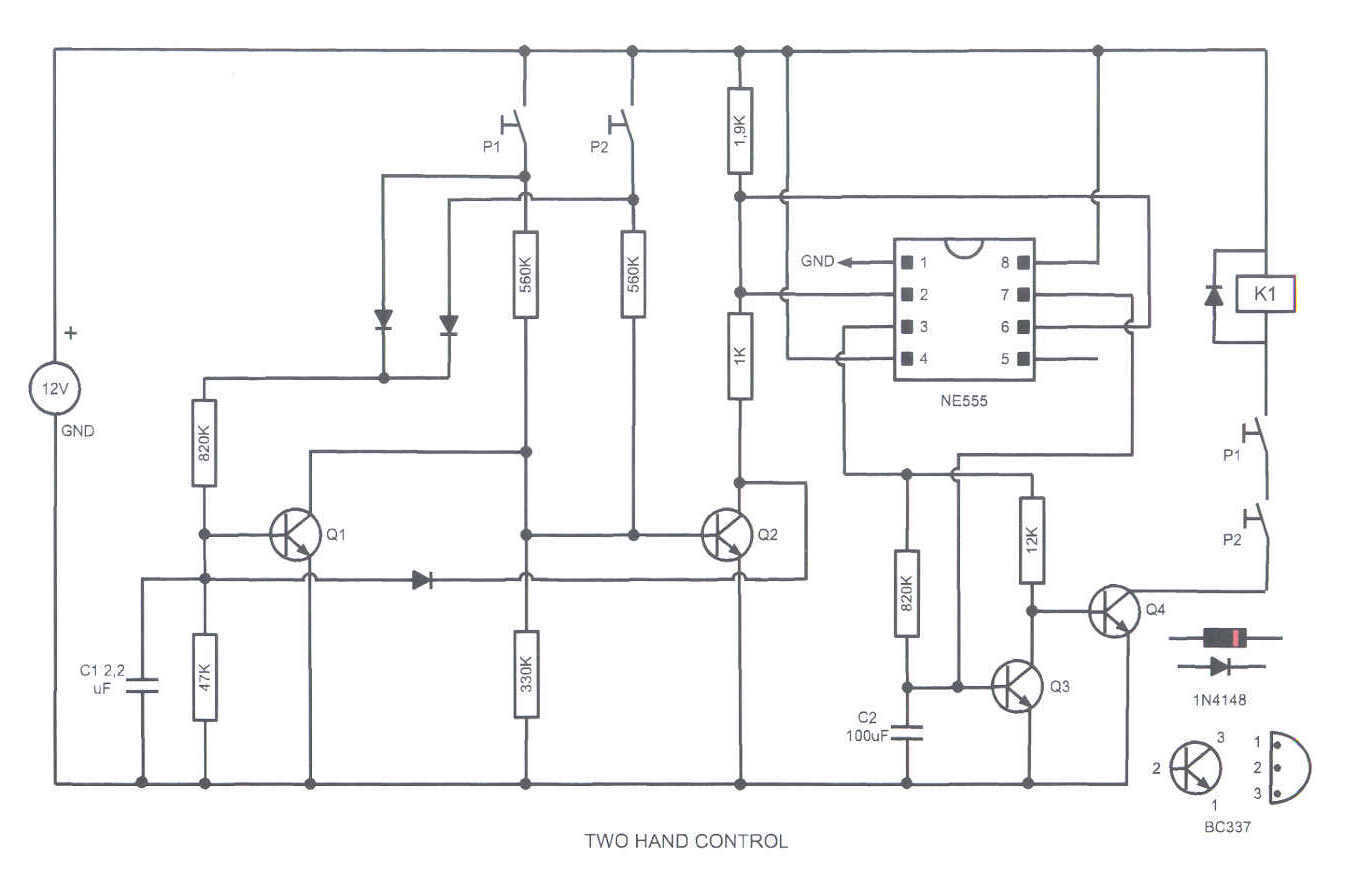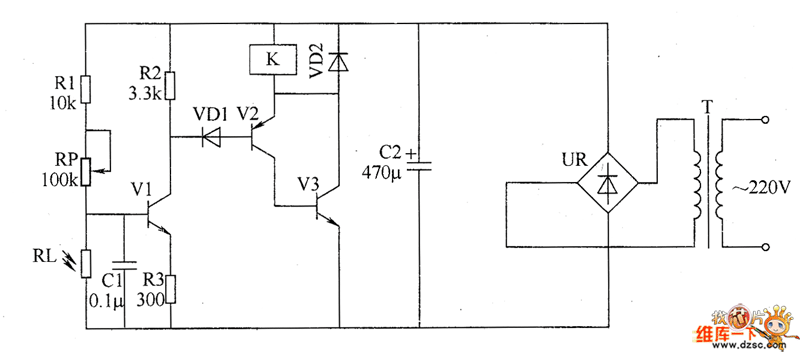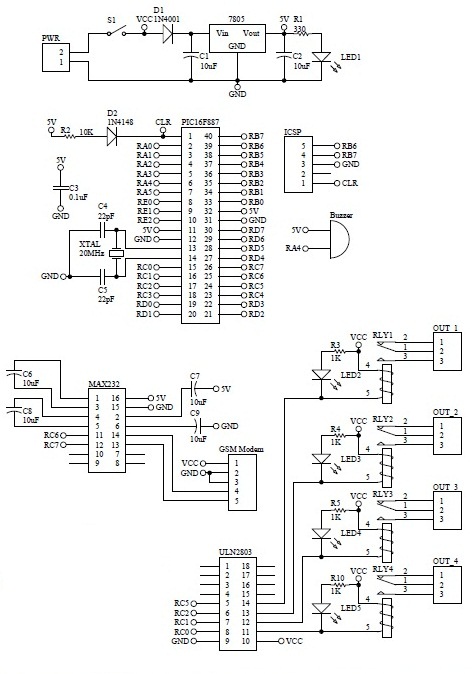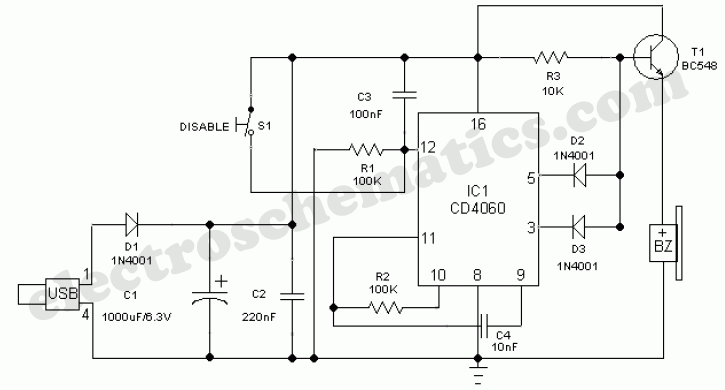
safety guard
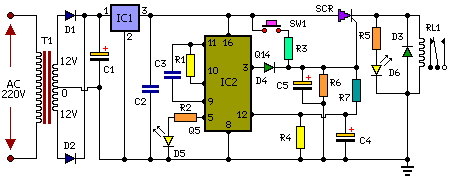
Safeguard home appliances against voltage spikes using a straightforward time delay circuit. When power is restored to the appliances after a mains failure, the oscillator begins oscillating, causing D5 to blink for a duration of three minutes. Following this period, the output Q14 of the IC CD4060 goes high, triggering the gate of the SCR via D4. At this point, voltage is present at the cathode of the SCR, energizing the relay coil to activate the appliance, indicated by the glowing of D6. The switch SW1 allows for a quick start without the need to wait for the delay.
The circuit employs an oscillator to manage the timing sequence that protects appliances from sudden power surges. The key component, the CD4060 IC, serves both as an oscillator and a frequency divider, generating a clock signal that drives the blinking of LED D5. This visual indicator provides a clear status of the circuit during the delay period.
Once the three-minute delay elapses, the output Q14 transitions to a high state. This change is crucial as it activates the gate of the silicon-controlled rectifier (SCR) via diode D4. The SCR acts as a switch that controls the high voltage supplied to the appliance. When triggered, the SCR allows current to flow from the anode to the cathode, thus energizing the relay coil. The relay, in turn, closes its contacts, allowing the appliance to operate safely.
The inclusion of D6 serves as an additional indicator, confirming that the appliance is now powered. The switch SW1 is a user-friendly feature that allows for immediate operation of the appliance without waiting for the three-minute countdown, providing flexibility in usage.
Overall, this time delay circuit not only protects appliances from voltage spikes but also offers a controlled startup sequence, enhancing the longevity and reliability of the connected devices.Protect your home appliances from voltage spikes with this simple time delay circuit. Whenever power to the appliances is switched on or resumes after mains failure, the oscillator starts oscillating and D5 blinks. This continues for three minutes. After that, Q14 output of IC CD4060 goes high to trigger the gate of the SCR through D4. At this moment, the voltage is available at the cathode of the SCR, which energizes the relay coil to activate the appliance and D6 glows.
Switch SW1 is used for quick start without waiting for delay.. 🔗 External reference
The circuit employs an oscillator to manage the timing sequence that protects appliances from sudden power surges. The key component, the CD4060 IC, serves both as an oscillator and a frequency divider, generating a clock signal that drives the blinking of LED D5. This visual indicator provides a clear status of the circuit during the delay period.
Once the three-minute delay elapses, the output Q14 transitions to a high state. This change is crucial as it activates the gate of the silicon-controlled rectifier (SCR) via diode D4. The SCR acts as a switch that controls the high voltage supplied to the appliance. When triggered, the SCR allows current to flow from the anode to the cathode, thus energizing the relay coil. The relay, in turn, closes its contacts, allowing the appliance to operate safely.
The inclusion of D6 serves as an additional indicator, confirming that the appliance is now powered. The switch SW1 is a user-friendly feature that allows for immediate operation of the appliance without waiting for the three-minute countdown, providing flexibility in usage.
Overall, this time delay circuit not only protects appliances from voltage spikes but also offers a controlled startup sequence, enhancing the longevity and reliability of the connected devices.Protect your home appliances from voltage spikes with this simple time delay circuit. Whenever power to the appliances is switched on or resumes after mains failure, the oscillator starts oscillating and D5 blinks. This continues for three minutes. After that, Q14 output of IC CD4060 goes high to trigger the gate of the SCR through D4. At this moment, the voltage is available at the cathode of the SCR, which energizes the relay coil to activate the appliance and D6 glows.
Switch SW1 is used for quick start without waiting for delay.. 🔗 External reference
